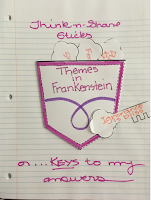Engaged Students
Engaged students are actively participating in relevant classroom lessons and activities. An expert teacher knows that most of their students should be engaged - most of the time. The alternative - disengagement - has extreme consequences on student learning.Think about your average question and answer session - a teacher asks a question and then cherry-picks for the answer - only engaging one or two students at most. For students: this is a ticket to let their minds wander - either actively or passively disengaged.
Don't Be a Plucker
This plucking answers from a group of students does not require students to actively participate and does not allow teachers to know who is learning, who has mastered a topic and who needs more help. An engaged classroom is one where every class session is used as a chance for formative assessment. Where most of the students are participating most of the time.So, how does one demand active participation and cognitive engagement? -- by eliciting feedback and requiring higher order thinking. It is imperative for us all to plan our pedagogy with the goal of including at least three or four opportunities for students to demonstrate understanding and to actively participate in each lesson. By doing this, we will be able to better analyze, synthesize and evaluation what our students know and how we need to proceed - each step of the way.
Yes, that sounds good, but how can you make this easy? Start with the end in mind - give students - whether in kindergarten or high school - the tools they need to engage.
Student Engagement Techniques and Templates
1. Individual white boards and white board markers - if you don't have white boards - laminate a piece of card stock.2. Have on hand: glue, markers, crayons, construction paper, scissors, paperclips, clay and highlighters. It is helpful to have one resource box for every four or five people - shoe boxes work great, as do dollar store plastic containers. Make sure they are easily accessible.
3. Use simple strategies and Ready-Made Templates. For example:
- When you pose a question ask students to think about the question, turn to their neighbor, partner, etc., and discuss an answer, then tell them they will have one, three, five minutes to come up with an answer - also tell them to make sure one person is prepared to report out their answer - this is a take on the basic think-pair-share.
- Quick Writes: A quick write can be done at any time - plan ahead by using prepared prompts or think on your feet as questions come up. Say, take the next two, five minutes to write down your thoughts on "the reasons John Adams and Thomas Jefferson's friendship suffered and what, if any, effect did that have on the government?" The process of journaling provides valuable information to form further instruction.
- Have interactive notebook templates on-hand - Interactive Notebook Pages for RL and RI - yes that means literation and information, so they are perfect for any subject.
- Quick Draws: Use a word back or a passage for your quick draw. Quick draws can be used for any subject and any topic - K through college. Pick a big idea from your lesson. Pose a question asking students the meaning of the concept and tell them to create a visual representation. Have students explain their drawings to a partner.
- Use a pocket fillable. Print out the pocket Interactive Notebook template, pose the question and tell students to work alone or in pairs to come up with - the best four answers to... - write three themes to Frankenstein on the front of a key, write how each theme is reflected in part 1 - put your keys into pocket.
By writing, discussing and drawing classroom concepts and topics students are better able to analyze various sides of a concept, as well as to visualize, explain and synthesize - thus realizing both the goal of active engagement and student access to higher order learning.
Please
follow Me:
Pinterest: https://www.pinterest.com/epinotti/boards/
Twitter: https://twitter.com/chapinpinotti
Google +: https://plus.google.com/u/0/
Tumblr: https://elizabethchapinpinotti.tumblr.com
Facebook: https://www.facebook.com/ReadingAllAround/
Thanks,
Elizabeth Chapin-Pinotti
#ChapinPinotti
Elizabeth Chapin-Pinotti
#ChapinPinotti





No comments:
Post a Comment